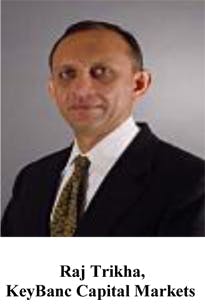Strategically speaking, Calumet Specialty Products Partners’ recent acquisition of Anchor Drilling Fluids USA Inc. was a typical under-the-radar move centered on the purchase of a small to mid-sized manufacturer. Calumet (IW 500/209), a $5.4 billion producer of hydrocarbon and fuel products, paid $235 million to acquire Anchor, which earned $26.3 million in 2013. Calumet expects Anchor to continue its healthy growth rate of 20% EBITDA (earnings before interest, taxes, depreciation and amortization), but that’s only part of the story here.
The Anchor deal is a microcosm of similar deals that happen all the time in what some are calling a “manufacturing renaissance,” and it illustrates clearly why manufacturing is considered the greatest opportunity for new investment in 2014. In this case, private equity firm American Capital, which first invested in Anchor back in 2005, ended up earning a 24% compounded annual return on its investment, to the tune of $33 million.
According to Dan Shea, managing director and head of private equity coverage for BDO Capital Advisors, “capital is available in abundance for mergers and acquisitions,” particularly for the manufacturing and distribution sector, which accounts for 18% of all deals in the U.S. In fact, private equity firms are currently sitting on nearly a half-trillion dollars ($466 billion) in raised but uninvested equity, and with the demand for acquisition targets exceeding the supply, “it’s a seller’s market right now for manufacturers,” Shea says. The private equity community believes there is a lot of value creation opportunity in U.S. manufacturing right now, Shea observes, and that situation should continue into the future. “It’s a refreshing shift from several years ago when offshoring was happening to a greater degree, most people were focusing on high-tech opportunities, and manufacturing was considered the unattractive step-child.”
Craig Everett, director of Pepperdine University’s Private Capital Markets Project, concurs, noting there is “an abundance of private equity capital currently on the sidelines looking for quality deals. Valuations are very high right now, making it a seller’s market for owners of businesses with strong financials and healthy growth trends.”
In Pepperdine’s recent study of nearly 1,000 privately-held businesses, two-thirds (65%) of respondents say they believe growth opportunities will increase over the next year. “The good news for businesses trying to expand is that interest rates continue to fall for commercial loans of nearly every size,” Everett says. “This low interest rate environment makes expansion very affordable for those firms that qualify for these loans.” He adds, though, that getting access to these funds is much easier for mid-market companies than it is for small businesses (less than $5 million in revenues).
The Energy Advantage
“We’re clearly seeing an upswing in investment interest in U.S. manufacturing, particularly in any business related to energy,” points out Raj Trikha, managing director and industrial group head at KeyBanc Capital Markets. “The fact that natural gas prices in the U.S. are cheaper than anywhere else in the world is driving investor sentiment.”
He lists the types of industries that are benefiting from that interest. “First, there is interest in any company that’s involved in accessing or transmitting natural gas or shale gas—businesses that make pipelines, or things like valves, pumps, motors, or welding products. Second, MRO products that are part of the process of searching for, accessing and transmitting natural gas and oil. Third, any industry that is a big user of energy, such as anything to do with chemicals. These might be chemicals that use a lot of natural gas for their production, or it might be for production of chemicals used in the hydraulic fracking itself. Basically, for any business that is energy-intensive, there is now a big cost differential for U.S.-based companies versus being in Europe.”
Besides companies enjoying the energy cost advantage, U.S. manufacturers in this country that are doing well right now are those that provide a high-value product that a customer needs on a quick-turn, short-run basis, as opposed to the long-run, less-value-added products that are typically offshored, according to Shea. “These are the manufacturers who have consistently achieved a higher margin, and private equity and strategic buyers have always been interested in them because they have a product that allows them to stay in this country and charge an attractive price for it.” This would include medical device manufacturers in particular, as well as producers of components used in the aerospace and defense industry.
A Strategy Based on Strong Business Development
“There’s a debate in the U.S. about a “manufacturing renaissance,” and what we’re seeing is that the number of jobs being shipped offshore vs. the number of jobs that are being created by reshoring has reached a balance, which is a real positive thing,” Shea says. He cites a number of reasons for why U.S. manufacturing has become so popular again. “First of all, you’re seeing a doubling of wages every five years in the low-cost Asian countries. In China there’s a 15-20% wage hike every year.”
Another advantage is the productivity of U.S. manufacturing. “You can do more with less here in the U.S. in terms of people and equipment,” he notes. “That’s definitely appealing to manufacturers and their customers.” Also, there is a shorter supply chain with fewer transportation costs when products are made in the U.S., along with less supply chain risk thanks to closer proximity to customers or suppliers.
While the narrowing of the wage gap between Asian and U.S. workers is one attractive component of the manufacturing renaissance, investors are focusing due diligence at the management team of companies they’re looking to fund. “There’s nothing better than past performance to excite new capital from private equity investors,” Shea states. “They’re entrusting their capital to a team, and the team can make or break a deal. Private equity investors want a team that’s got fire in their belly, and a key element of the private equity formula typically is incenting the management team with options. They’ll typically reserve anywhere between 5 and 15 percent of the company for sweat equity, so they’re looking for people that they can trust to be stewards of their equity capital.”
To that end, private equity investors are creating compensation structures that allow the management team to continue to do what they’ve done in the past to create value, and maybe even accelerate it, Shea points out.
So what can owners do to increase the value of their manufacturing business? “Hopefully the majority of manufacturers are thinking of the basics of sound business development strategy,” Shea says. “That means, they should be focusing on developing and constantly improving their products and services, building out their management team, making sure that they reduce reliance on too few customers and too few suppliers, constantly investing in manufacturing technology as well as lean manufacturing. All of these things play a huge role when it comes time to actually find out what the real value of your business is.”
“Most private equity groups are not interested in just buying a company and maintaining status quo. They want to see that business grow,” Trikha explains. Now, that growth can be if the end markets that company is serving are growing at a nice rate, but ideally it has that but also opportunities to make some additional acquisitions so the pie can grow. We spend a lot of time with companies helping them understand the growth opportunities in their business, whether it’s from entering new markets, developing new product lines and expanding into adjacent markets. They also need to look at what businesses they might be able to access or buy in the next two or three years. Once they have that growth metric mapped out reasonably well, that starts to answer the question of how much capital they need.”
About the Author
Dave Blanchard
Senior Director of Content
Focus: Supply Chain
Call: (941) 208-4370
Follow on Twitter @SupplyChainDave
During his career Dave Blanchard has led the editorial management of many of Endeavor Business Media's best-known brands, including IndustryWeek, EHS Today, Material Handling & Logistics, Logistics Today, Supply Chain Technology News, and Business Finance. He also serves as senior content director of the annual Safety Leadership Conference. With over 30 years of B2B media experience, Dave literally wrote the book on supply chain management, Supply Chain Management Best Practices (John Wiley & Sons, 2010), which has been translated into several languages and is currently in its second edition. He is a frequent speaker and moderator at major trade shows and conferences, and has won numerous awards for writing and editing. He is a voting member of the jury of the Logistics Hall of Fame, and is a graduate of Northern Illinois University.



